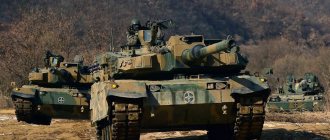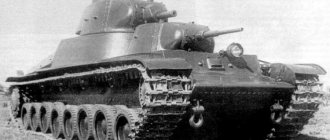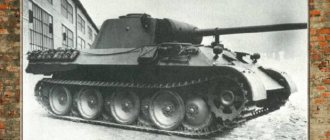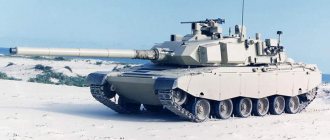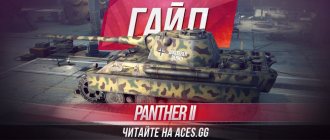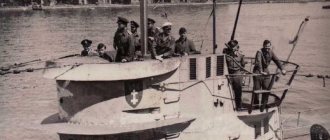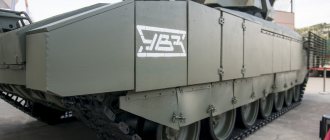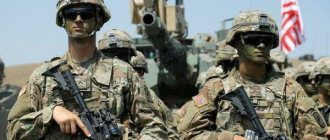History of creation
When the Germans encountered Soviet T-34s at the beginning of World War II, they experienced a real shock - this tank was superior to all German armored vehicles of that time. Therefore, already in 1941, it was decided to begin development of a new German medium tank. In general, work on such a machine had been going on since 1938, but the T-34 greatly spurred them on.
In November 1941, MAN and Daimler-Benz were given technical specifications for a new combat vehicle weighing 35 tons, an engine of 600-700 horsepower and 40 mm armor protection. The new tank was immediately given the name “Panther”. And a little earlier they began to develop a new 75 mm tank gun, to penetrate 140 mm armor at a distance of a kilometer.
German designers carefully studied captured examples of enemy tanks, especially the T-34, and in the spring both companies presented their prototypes. The tank from Daimler-Benz turned out to be too similar to the T-34, but overall Hitler liked it. The tank from MAN had a more traditional German layout and appearance. By the way, both companies abandoned the Christie suspension, which was used in the T-34, due to its archaic nature.
To choose from two options, a special “Panther Commission” was assembled. In May, after numerous tests and discussions, she finally decided that the MAN tank was more suitable for the German army.
The Germans considered the tank to be medium because vehicles with guns with a caliber greater than 75 mm were heavy. At the same time, the finished vehicle weighed 44 tons, which according to all other classifications made it a heavy tank.
At the end of 1942, two prototypes were built. During operation, various shortcomings were identified, which were corrected literally on the fly. And already in January 1943, the first production Pz.Kpfw.V Panther vehicle rolled off the production line. By the way, the tank began to be called simply “Panther” only at the beginning of 1944 - previously the index Pz.Kpfw.V was always used to designate it.
Panther Ausf. D1, first modification
Engine Maybach HL 230 P30;
In general, the new engines are much more reliable than their predecessors. Sometimes the engine travels up to 1700-1800 km without repair, and 3 “Panthers”, having covered this distance, are still running. But the nature of the breakdowns has not changed: destruction of mechanical parts and damage to bearings.Engine fires:
The number of fires in the engine compartment has decreased significantly. The following causes of fires have been identified:
- Oil leaks through valves due to poor seals. Drops of oil fall onto the hot exhaust pipes and ignite.
- In some cases, the carburetor overflows. The spark plugs are filled with gasoline and do not produce a spark. Unburned fuel is then released into the exhaust pipes and leaks out through the seals, causing a fire.
Transmission:
The service life of the transmission has also increased. On average, every 1,500 km, the 3rd gear fails, and the failure cannot be repaired in the field. The failure of the 3rd gear is explained by its overload when driving in mud. Since transmission replacement is sometimes not possible, we operated three Panthers with faulty transmissions. Shifting from 2nd straight to 4th gear sometimes caused the clutch to break, but the clutch is much easier to repair. It happens that tanks travel 1500–1800 km without clutch failure, and 4 Panthers have already broken this record.
Rapid wear of the steering is also due to constant off-road driving. The steering system has a rather complex design, and the qualifications of the driver mechanics are not enough to independently eliminate the malfunctions that arise. Therefore, tanks are controlled using on-board brakes, which leads to their rapid wear and frequent failure.
Final drives:
Very often tanks fail due to breakdowns of final drives. For example, on March 11, final drives had to be replaced on 30 tanks. The left final drive fails more often than the right one. The bolts on the large final drive gear often break off. Reversing in mud has a particularly adverse effect on final drives.
TTX
general information
- Classification – medium tank according to the German classification;
- Combat weight - 44.8 tons;
- Layout – engine compartment at the rear, controls at the front;
- Crew – 5 people;
- Years of production – 1942-1945;
- Years of operation – 1943-1947;
- A total of 5976 pieces were produced.
Dimensions
- Case length – 6870 mm;
- Length with gun forward – 8660 mm;
- Case width – 3270 mm;
- Height – 2995 mm;
- Ground clearance – 560 mm.
Booking
- Type of armor – rolled, medium and low hardness, surface hardened;
- Body forehead, top - 80/55° mm/degree;
- Hull side, top - 50/30° mm/degree;
- Hull rear, top - 40/30° mm/degree;
- Bottom – 17-30 mm;
- Housing roof – 17 mm;
- Turret forehead – 110/10° mm/degree;
- Gun mantlet – 100 mm, cast;
- Turret side - 45/25° mm/degree;
- Feed cutting - 45/25° mm/degree.
Armament
- Caliber and brand of gun – 75 mm KwK 42;
- Barrel length – 70 calibers;
- Gun ammunition - 81;
- Machine guns - 2 × 7.92 MG-42.
Mobility
- Engine type – carburetor, 12-cylinder, V-shaped;
- Power – 700 horsepower;
- Highway speed – 55 km/h;
- Speed over rough terrain – 25-30 km/h;
- Cruising range on the highway – 250 km;
- Specific power – 15.6 hp. per ton;
- Suspension type: torsion bar.
Description of design
The tank's hull was assembled from rolled surface-hardened armor plates of medium and low hardness, connected "into a tenon" and welded with a double seam. The upper frontal part (ULD) with a thickness of 80 mm had a rational angle of inclination of 57° relative to the normal to the horizontal plane. The lower frontal part (LLD), 60 mm thick, was installed at an angle of 53° to the normal. The data obtained when measuring the captured Panther at the Kubinka training ground differed somewhat from the above: the 85 mm thick VLD had an inclination of 55 ° to the normal, the NLD - 65 mm and 55 °, respectively. The upper side sheets of the hull were 40 mm thick (on later modifications - 50 mm) inclined to the normal at an angle of 42°, the lower ones were installed vertically and had a thickness of 40 mm. The 40 mm thick feed sheet is inclined to the normal at an angle of 30°. In the roof of the hull above the control compartment there were manholes for the driver and gunner-radio operator. The hatch covers were lifted up and moved to the side, like on modern tanks. The rear part of the tank hull was divided by armored partitions into 3 compartments; when overcoming water obstacles, the compartments closest to the sides of the tank could be filled with water, but water did not get into the middle compartment where the engine was located. At the bottom of the hull there were technological hatches for access to the suspension torsion bars, drain valves of the power supply, cooling and lubrication systems, the pump and the drain plug of the gearbox housing.
The Panther turret was a welded structure made of rolled armor plates connected into a tenon. The thickness of the side and rear sheets of the tower is 45 mm, the inclination to the normal is 25°. A gun was mounted in a cast mantlet in front of the turret. The thickness of the gun mask is 100 mm. The rotation of the turret was carried out by a hydraulic mechanism that took power from the tank engine; the rotation speed of the turret depended on engine speed, at 2500 rpm. the turret rotation time was 17 seconds to the right and 18 seconds to the left. A manual drive for turret rotation was also provided; 1000 revolutions of the flywheel corresponded to a 360° rotation of the turret. The tank's turret was unbalanced, which made it impossible to turn it manually at a roll of more than 5°. The thickness of the turret roof was 17 mm; on the Ausf G modification it was increased to 30 mm. A commander's cupola was installed on the roof of the tower, with 6 (later 7) observation devices.
Modifications
- Pz.Kpfw.V Panther Ausf. D1 – the first twenty production cars. They never took part in battles - crews were trained for them in the rear. The vehicles had an HL 210 P45 engine and 60 mm frontal armor;
- Ausf. D2 is the first production modification, very similar to D1. The frontal armor was strengthened, the commander's turret and muzzle brake acquired a “Panther” look;
- Ausf. A - modification with a new turret, without embrasures and small hatches, with a more convenient sight and the usual ball mount for a front-line machine gun. The vehicles were often equipped with bulwarks;
- Ausf. G – the most widespread modification, produced since the spring of 1944, with reinforced armor. Some “Panthers” were equipped with a gun mantlet with a “skirt” so that the turret would not jam from hits from enemy shells;
- Ausf. F - the latest modification, was developed in the fall of 1944. It was supposed to be even more protected, but until the end of the war only a few hulls and turrets were produced and not a single prototype was assembled.
In the fall of 1943, they began to develop a second “Panther”, which would be equipped with an 88-mm cannon, like on the Royal Tiger, and a new turret, that is, a kind of lightweight second Tiger. But a suitable engine for the car was never found.
Tower Ausf. F
Panther II prototype image
Alternative versions
Age of Ultron
During Age of Ultron
Black Panther contacts the Fantastic Four, informing them of the approach of Ultron and his army of robots. He later spies on Ultron's minions with Red Hulk and Taskmaster. When they are attacked by an entire army of robots, Red Hulk confronts them while Black Panther and Taskmaster escape. An explosion occurs, causing the Panther to fall from a height and break his neck, resulting in instant death.
Amalgam Comics
In this version, the Bronze Panther appears - the ruler of Wakanda named B'Nchalla. He was created from the images of Bronze Tiger (DC) and Black Panther (Marvel).
Earth 6606
T'Challa calls himself the Leader of Justice
and is a member of Captain Britain's corps.
He appeared in Excalibur
#44 (1991).
Earth X
In the alternate reality Earth X
T'Challa was affected by a mutation. Like many people, he mutates into a humanoid panther. Captain America entrusted him with the Cosmic Cube because he knew that T'Challa would resist his power and would not give it to anyone even under the threat of death. However, T'Challa refused him.
Vehicles based on the Panther tank
- Jagdpanther is a heavy self-propelled gun, tank destroyer. It was developed after Ferdinand's success at Kursk as a new self-propelled gun on a more mobile chassis from the Panther. One of the best self-propelled guns of that time, with good armor and firepower;
- Bergepanther is an armored repair and recovery vehicle. Instead of a tower, an open platform, a winch and a crane were placed on it. There was a machine gun for defense. It was also considered the best ARV of World War II.
Jagdpanther
Several Panther-based vehicles remain at the project or prototype stage:
- Panzerbeobachtungswagen Panther - artillery observer tank - instead of a cannon, a wooden model was installed. The vehicle had several periscopes and a stereoscopic rangefinder. Either one copy or 41 cars were built, there is no exact data;
- There were several self-propelled gun projects on the Panther chassis, but all of them did not even become prototypes and remained only on paper;
- There were also several projects of anti-aircraft self-propelled guns based on the Panther. Many rejected it, but in 1944 they finally accepted the Flakpanzer “Coelian” ZSU project. Only a mock-up was built, the prototype was never made.
Flakpanzer "Coelian", mockup
Combat use
The Panthers began their combat career in July 1943, and during 22 months of service they managed to visit the Italian, Western and Eastern Fronts.
The first major battle in which they participated was Operation Citadel. Many of the leadership were wary of the operation, noting, among other things, that the “Panthers”, which others so hope for, are not yet ideal and require testing. As a result, the attack was postponed, which gave the Soviet troops the opportunity to improve their defenses. The Germans mainly took part in the battle from the Tigers, Pz Kpfw IV and Pz Kpfw III, but the Panthers actually constantly broke down and burned - out of 200 vehicles, 160 were out of action, and many could not be evacuated.
While the Soviet offensive was underway, the PzKpfw V's shortcomings were corrected, and they finally became combat-ready. Sometimes it was possible to carry out effective counterattacks. Often, Panthers and other tanks were used to quickly move to different locations to hold off the advance of the Red Army. For example, in the battle near Balabanovka, the Vaeske regiment inflicted very serious damage on the enemy, losing only five Panthers and one Tiger.
Tanks participated quite actively in battles in Ukraine, especially near Kamenets-Podolsk. General Hube showed himself well there, although there were weather conditions against the German tanks - the vehicles constantly broke down due to muddy roads.
After the death of Hube, the First Panzer Army clearly needed a little respite, but Hitler refused it. Despite the fairly high efficiency of the Panthers, the Germans were no longer able to restrain the Soviet troops.
In the West
In the West, “Panthers” also actively participated in battles and caused serious damage to the allies. The British and Americans believed that in order to knock out one PzKpfw V it was necessary to lose five Cromwells or Shermans. But the numerical superiority of the Allies did its job here too. In addition, it was forbidden to retreat, and tanks were often hit by artillery attacks, and the terrain of Normandy was completely unsuitable for tanks. The only major success in this zone was the elimination of the British breakthrough at Villers-Bocage.
The battles went differently - on July 11, 1944, the Paters were badly damaged in a battle against Allied tank destroyers, but already on the 18th of the same month, the First SS Panzer Corps stopped three British tank divisions.
Knocked-out Panther
The Panthers took part in Operation Liège, but almost half of the tanks were destroyed by Allied aircraft. Also, many tanks were lost in the encirclement near Falaise. However, intelligence reported that the Panther was becoming more and more reliable, and it was already considered the most dangerous tank in Germany.
The last major operation on the Western Front in which the Panthers participated was the Ardennes offensive. The operation failed with the loss of almost all tanks. And although the PzKpfw V showed itself to be very effective, there were too few of them.
In general, experts believe that the Panther was the best German medium tank of the Second World War, but it needed a little polishing - it was superior to the Pz Kpfw IV in all respects except reliability, but in 1943 reliability was not as important as power , speed and reservation.
Powers and abilities
T'Challa's physical strength is significantly greater than that of the average human at his peak, being able to lift just under 800 pounds (362.8 kg).
T'Challa can reach speeds of up to 35 mph (56.327 km/h). T'Challa's musculature produces fewer fatigue toxins than most people. His body is capable of healing injuries that would be fatal to ordinary people. T'Challa's agility is also enhanced to the peak of human development. T'Challa can see in complete darkness as if it were a clear sunny day, and at a distance of several hundred feet he can see objects as if they were right in front of his face. T'Challa's hearing is enhanced in the same way, allowing him to hear sounds that a normal person cannot hear, and is also able to hear at greater distances that a normal person cannot hear. T'Challa can remember tens of thousands of scents and track them to precise locations, and can also smell fear. T'Challa's taste is so developed that he is able to determine the exact ingredients of the food he eats.
As the King of Wakanda, Black Panther has the right to eat a special form of heart-shaped grass, which gives him superhuman senses and increases his strength, speed, endurance and agility. However, T'Challa later refused this privilege.
Equipment
- Kimoyo card: a very powerful and versatile PDA. It has similar functionality to the Avengers Communicator, but with much larger and more useful applications.
- Energy Boots: Energy Regulators create variable vibranium fields on the boot's textured soles, saving the Panther on more than one occasion and allowing him to land on his feet like a cat. With enough momentum, the Panther can climb walls or glide through water.
- Vibranium Network
- Mask Lenses: Increases the Panther's natural night vision.
- Cloaking Technology: The cloak can stretch, shrink, or disappear at the will of the mind. In addition, the entire costume can become similar to ordinary street clothes.
- Heavy Armor: Provides protection during battle, controlled mentally.
- Movement: Advanced Wakandan Aircraft.
Weapon
:
- Energy Dagger: With an ornate hilt carved from ivory or some kind of stone. The blade can be used to stun and kill. Energy blades can be held like a regular knife or thrown like darts. They recover quickly.
- Anti-Metal Claws: The claws on the gloves are made from Antarctic vibranium-like "Anti-Metal", and are capable of breaking most metals.
- He also uses the Ebony Blade when possible.
Tank in culture
The Panther tank was very widespread, so that it can be found in almost all computer and mobile games dedicated to the Second World War, such as Blitzkrieg, Panzer General and others. It also exists in games about tank battles,
The Panther tank can be seen in the following computer games: World of Tanks and War Thunder.
Very often in games the performance characteristics of a tank do not coincide with the real ones.
"Panthers" can be seen in the 1949 Soviet film "The Fall of Berlin" - real tanks on the move took part in the filming.
There are also quite a few models of the Panther, produced by different companies, including the Russian Zvezda. There are both plastic and paper models for bench modeling.
Painted model
Outside of comics
Cartoon series
- Black Panther acted in the 1994 Fantastic Four series. In order to test his readiness for a battle with a villain named Klaw, T'Challa tries his hand at the Fantastic Four and loses. But the Fantastic Four helps him defeat the villain. He was voiced by Keith David.
- Black Panther appeared in one episode of the animated series Iron Man. Adventures in Armor,” where he was voiced by Jeffrey Bauer-Chapman.
- Black Panther appeared in the animated comedy series Super Hero Squad, where he was voiced by Taye Diggs.
- Black Panther, voiced by Djimon Hounsou, is the main character of his own six-part animated series, Black Panther, made in the style of an animated comic book. This animated series states that Wakanda has resisted invaders for at least 25 centuries and has not attacked anyone itself, and the Black Panther
is a royal title that one day a year can be received by any resident of Wakanda if he defeats the former king. - Black Panther is a recurring character in the animated series The Avengers: Earth's Mightiest Heroes. Here he asks the Avengers to help dethrone the villain named Man-Ape from the throne of Wakanda. After defeating the enemy, he joined the Avengers and helped the team out several times. Here he was voiced by James Mathis.
Movies
Main articles: Marvel Cinematic Universe
,
Captain America: Civil War
,
Black Panther (film)
,
Avengers: Infinity War
and
Avengers: Endgame On
October 29, 2014, Marvel announced the appearance of Black Panther in the Marvel Cinematic Universe and the start of work on a solo film about him.
- For the first time in the MCU, Black Panther appears in the film Captain America: Civil War. In the film, he advocates registration and takes revenge on Bucky Barnes for killing his father, keeping an eye on Stark to bring him to him. In the finale, he learns that the real killer is Baron Zemo and leaves the scene. Subsequently, he puts Zemo in prison and also freezes Bucky at his personal request. His role in the film was played by Chadwick Boseman.
- Chadwick Boseman returned to the role of Black Panther in the solo film Black Panther, which premiered on February 26, 2018.
- Black Panther also appeared in the film Avengers: Infinity War. He is reprized by Chadwick Boseman.
- Chadwick Boseman also played Black Panther in Avengers: Endgame.
Full-length cartoons
- Black Panther is one of the main characters in the animated film Ultimate Avengers 2, in which he was voiced by Jeffrey D. Sams.
- Black Panther is mentioned in the cartoon "The New Avengers: Heroes of Tomorrow", in which his son Azari acts along with the children of other superheroes.
Games
- Black Panther is unlocked for 5 of his statues in the game Marvel: Ultimate Alliance.
- He is one of the characters in the game Marvel Heroes Online.
- A minor character in the video game LEGO Marvel Super Heroes.
- Character from the game Marvel Puzzle Quest Dark Reign
- Playable character in Marvel: Ultimate Alliance 2
- Playable character in Marvel Contest of Champions on Android and IOS
- Character in the mobile game Marvel Future Fight
- Playable character in Marvel VS. Capcom: Infinite
Memory of a tank
16 “Panthers” have survived to this day in good condition. Three are in Belgium, 2 are in Great Britain, all modifications are G. In Germany and Canada you can see Ausf. A, in the Netherlands – Ausf. D and Ausf. G. In Russia, the Panther Ausf. is exhibited in Kubinka. G, restored to running condition. Five cars of modifications A and G are in various museums in the USA. Four modification A tanks are on display in France, one Ausf. D is available in Switzerland.
Panther in Kubinka
Links
World of Tanks Resources
- Tank science
- Thread on the official forum
- Recordings of battles on GW Panther
On the Internet
GW-Panther // Wikipedia
German technology
| Light tanks | I Leichttraktor • II Pz.Kpfw. II Ausf. D • II MKA • II Pz.Kpfw. 38H 735 (f) • II Pz.Kpfw. 35 (t) • II Pz.Kpfw. I • II Pz.Kpfw. II • III 43 M. Toldi III • III Pz.Kpfw. 38 (t) • III Pz.Kpfw. III Ausf. E • III Pz.Kpfw. II Ausf. J • III Pz.Kpfw. I Ausf. C • III Pz.Kpfw. II Ausf. G • III Pz.Kpfw. T 15 • IV Pz.Kpfw. 38 (t) nA • IV Pz.Kpfw. II Luchs • V VK 16.02 Leopard • VI VK 28.01 • VII Aufklärungspanzer Panther • VII Spähpanzer SP IC • VIII leKpz M 41 90 mm • VIII leKpz M 41 90 mm GF • VIII HWK 12 • VIII HWK 30 • IX Spähpanzer Ru 251 • X Rheinmetall Panzerwagen |
| Medium tanks | III Großtraktor – Krupp • III Pz.Kpfw. IV Ausf. A • III Pz.Kpfw. S35 739 (f) • IV Pz.Kpfw. III Ausf. J • IV Pz.Kpfw. IV Ausf. D • IV VK 20.01 (D) • V Pz.Kpfw. III Ausf. K • V Turán III prototípus • V Pz.Kpfw. III/IV • V Pz.Kpfw. IV hydrostat. • V Pz.Kpfw. V/IV • V Pz.Kpfw. V/IV Alpha • V Pz.Kpfw. IV Ausf. H • V Pz.Kpfw. T 25 • V VK 30.01 (H) • VI Pz.Kpfw. IV Schmalturm • VI VK 30.01 (D) • VI VK 30.02 (M) • VII Panther/M10 • VII Panther • VII VK 30.02 (D) • VIII Panther mit 8.8 cm L/71 • VIII Schwarzpanzer 58 • VIII Panzer 58 Mutz • VIII M48A2 Räumpanzer • VIII Indien-Panzer • VIII Panther II • IX E 50 • IX T 55A • IX Kampfpanzer 50 t • IX Leopard Prototyp A • X E 50 Ausf. M • X Leopard 1 |
| Heavy tanks | IV Pz.Kpfw. B2 740 (f) • IV Durchbruchswagen 2 • VI Tiger 131 • VI VK 30.01 (P) • VI VK 36.01 (H) • VII VK 45.03 • VII Tiger I • VII Tiger (P) • VIII VK 100.01 (P) • VIII VK 168.01 (P) • VIII VK 168.01 Mauerbrecher • VIII VK 75.01 (K) • VIII E 75 TS • VIII Löwe • VIII Tiger II • VIII VK 45.02 (P) Ausf. A • IX E 75 • IX Mäuschen • IX VK 45.02 (P) Ausf. B • X E 100 • X Pz.Kpfw. VII • X Maus • X VK 72.01 (K) |
| Tank destroyer | II Panzerjäger I • III Marder II • IV StuG III Ausf. B • IV Jagdpanzer 38(t) Hetzer • IV Marder 38T • V StuG IV • V Pz.Sfl. IVc • V StuG III Ausf. G • VI Dicker Max • VI Jagdpanzer IV • VI Nashorn • VII E 25 • VII Krupp-Steyr Waffenträger • VII Jagdpanther • VII Sturer Emil • VIII Ferdinand • VIII Kanonenjagdpanzer 105 • VIII Rheinmetall Skorpion G • VIII Rheinmetall Skorpion • VIII Jagdpanther II • VIII 8.8 cm Pak 43 Jagdtiger • VIII Rhm.-Borsig Waffenträger • IX Jagdtiger • IX Waffenträger auf Pz. IV • X Grille 15 • X Jagdpanzer E 100 • X Waffenträger auf E 100 |
| self-propelled guns | II G.Pz. Mk. VI (e) • III Sturmpanzer I Bison • III Wespe • IV Pz.Sfl. IVb • IV Sturmpanzer II • V Grille • VI Hummel • VII GW Panther • VIII GW Tiger (P) • IX GW Tiger • X GW E 100 |
self-propelled guns
| USSR technology | II SU-18 • III SU-26 • IV SU-5 • V SU-122A • VI SU-8 • VII S-51 • VII SU-14-1 • VIII SU-14-2 • IX 212A • X Object 261 |
| German technology | II G.Pz. Mk. VI (e) • III Sturmpanzer I Bison • III Wespe • IV Pz.Sfl. IVb • IV Sturmpanzer II • V Grille • VI Hummel • VII GW Panther • VIII GW Tiger (P) • IX GW Tiger • X GW E 100 |
| US technology | II T1 HMC • III T18 HMC • III M7 Priest • IV T82 HMC • IV M37 • V M41 HMC • VI M44 • VII M12 • VIII M40/M43 • IX M53/M55 • X T92 HMC |
| French technology | II Renault FT 75 BS • III Lorraine 39L AM • IV AMX 105 AM mle. 47 • V AMX 13 105 AM mle. 50 • V 105 leFH18B2 • VI AMX 13 F3 AM • VII Lorraine 155 mle. 50 • VIII Lorraine 155 ml. 51 • IX Bat.-Châtillon 155 55 • X Bat.-Châtillon 155 58 |
| UK technology | II Loyd Gun Carriage • III Sexton II • III Sexton I • IV Birch Gun • V Bishop • VI FV304 • VII Crusader 5.5-in. SP • VIII FV207 • IX FV3805 • X Conqueror Gun Carriage |

